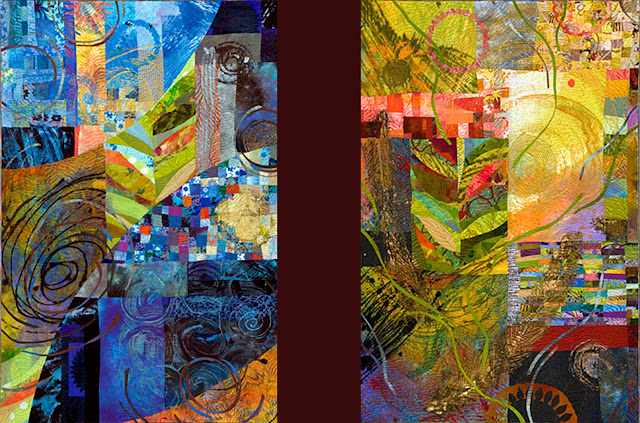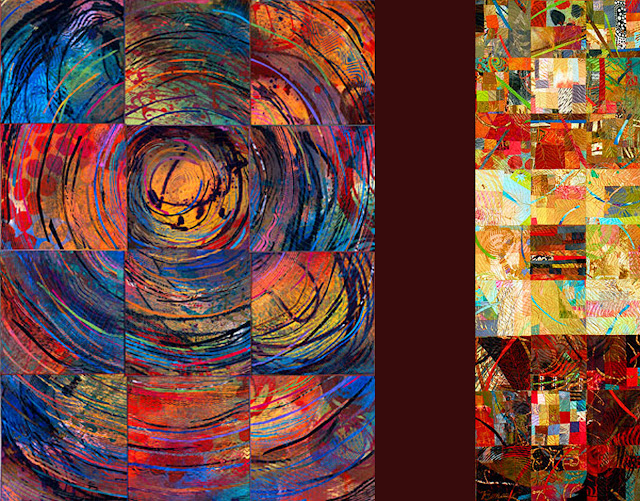 |
| Nest II |
Sue Benner - born in 1955 in Iron River in the upper peninsula of Michigan and raised in Oshkosh, Wisconsin, is a full time studio artist creating art quilts and other dyed and painted fabric constructions since 1980 when she became one of the first studio artist, before even the word “Art Quilt” was made popular.
Sue is an innovator in her field, creating original dyed and painted fabrics, which she combines with recycled textiles to form fields of structured pattern, vivid beauty, and riotous variation. There is always an underlying structure in her work, a set of rules. She thinks of each piece as a small world where she can declare the laws of nature.
 |
| Walking Through Time I |
Her love affair with fabric began with her first memories of the clothes her mother made her, recalling exact hue, fibre content, and weave. In the following years, her mother taught her to sew, carefully and creatively. Her father always had a pencil in his hand or behind his ear, drawing on napkins in restaurants and painting on the weekends. He inspired and encouraged her in art. Her education in molecular biology and medical illustration still figures in her work with an underlying sense structure and organizing principles.
She sees a direct connection with the concept of quilt and the assembly of units to make a larger whole. She works on 5-10 quilts at a time, often in two different series. This way of working suits the nature of her mind. Series and ideas overlap, playing off of one another. She uses her visual vocabulary to weave her work together, creating patterns and layers of meaning. She revels in the simple act of placing one fabric next to another.
 |
| Nests with Blue Walking Through Time II Red Leaves | |
Sue Benner is best known locally for her hand-painted bandanas, shirts, T-shirts and quilts with geometric or Texana imagery. In the last few years, however, this talented Dallas artist has garnered a growing, national reputation for creating giant, site-specific, three-dimensional color fabric constructions for large architectural spaces.
Benner carefully extrapolates the ambient colors, textures and shapes of an existing decor into lush, liquid flowing waterfalls of eye-catching color. Up close, her Spills, Falls and Currents reveal lush complexities of assembled soft forms and multi-layered abstract color paint and drawings.
 |
| Studio History |
Although she variously combines dye, batik, stitching, quilting, appliqué, draping and other forms, the watchword for Benner's work is "paint." Her installations and constructions are paintings on fabric. They are never submerged in a vat of dye. Always they involve direct paint techniques. Indeed, it is this action painting on selected fabrics-and the fact that she is essentially self-taught-that makes her art unique.
 |
| Dusk New Day |
The major breakthrough in her style came during a traumatic time after a breakup. "I was pouring my heart on this white piece of fabric" while "making use of the quality of the dyes," she said. The hue-saturated designs became Xed-out hearts. But it wasn't just serendipity. Benner was learning to use "the essential qualities of the dyes and the way they interact"-to make dye do what it does best. Already she knew, she needn't stay within the little wax lines. She discovered "I could just slop that stuff in very much the same way 20th Century American artists have been slopping paint on canvas."
 |
Cellular Structure I Cellular Structure II |
The Xs are gone, but hearts have become an important element of her design repertory through her six-year professional career. This is odd because the Valentine hearts are anatomically incorrect. Benner's own art history began during the last year of a B.S. in Molecular Biology at the University of Wisconsin -eighty miles from her home in Oshkosh and continued through a short but colorful career in medical illustration.
The summer before Sue graduated, a friend taught her to batik. She'd worked with fabric since she was five and loved working with her hands to make pretty things. But it was an elective course in Fabric Design that tied it all together. She barely got into the class but took to fabric art immediately.
 |
| Nest I Dark Center |
Gradually, Benner combined her sewing and quilting with batik. Then she added biology, and that unusual mix led to her honors thesis, Experiments in Illustrating the Human Reproductive System. She created 20 vivid organic forms on batiked and quilted fabric, watercolors and drawings.
After that very successful thesis, Sue added summer studio classes, then two more semesters of art to meet requirements for Medical Illustration School at the University of Texas Health Science Center in Dallas, where she's lived ever since.
 |
| Sink or Swim #23, #24 |
Although her Biomedical Scientific Technical Illustrations were superb, her medical art career was short-circuited two years later when someone saw The Life Story of Seminiferous Tubules, silk quilts for her Masters Thesis. If she could illustrate complex biology in such controlled detail, they reasoned, she could easily do fabrics for clothing. Soon, Benner was working with another Dallas designer, and when the fad for hand-painted fabric started, she was already in the thick of it. In spring 1981, she convinced Richard Brooks Fabrics to sponsor a show of her scarves, paintings and quilts on his silk crepe de chine, silk broadcloth and other fine fabrics.
 |
| Cellular Structure III Nine Times
Nine
|
The show sold well, but
more importantly, Dallas art rep Michael Thomas saw her paintings and told her
she could make a lot more selling them as art. After that, things started
clicking for Benner's art career, and she put her thesis on hold for four
years.
She got her first major
installation job by lucky accident. A decorator firm where a friend worked had
forgotten a hotel atrium, and they were desperate for a major installation.
They needed a young, energetic no-name artist they could get away with paying
what, for Benner, was a dream price. But it had to be completed in two months.
Sue had five hours to conceive it and make a presentation. In that flurry of
design and color, she had the idea for the drawstring-like balloon drapes that
gave it and others since a rippling three-dimensionality. Benner was confident
she could make the giant piece; she just didn't know how. But she poured
herself into the task, and the assembled 70' x 10' cascade of reds and greens,
Silk Falls, at Atlanta's Ramada Renaissance Hotel established her installations
career.
 |
Display II
|
Major commissions-like
her recent Silk Spills at the Texas American Bank in Fort Worth, now take six
months to a year. They must be previsualized and color-coordinated; pictures
need to be drawn, models made, and the whole project presented, budgeted and
each step approved. "I'm very good about thinking what I want the end
product to look like and then figuring out the steps to achieve that," she
explained.
Between the big
jobs, she experiments with littler ones. Among her inventory are vibrant
paintings on silk, richly patterned art quilts, subtly stitched collages,
draped and gathered fabric constructions and fashion items like bandannas,
scarves, T- and Hawaiian shirts, and yardage for clothing and upholstery to be
constructed by friends.
 |
Nest III Nest IV
|
"My work may
not seem normal to anybody else, but when you do it every day, you have to get
outside of that."
The smaller paintings'
quick turnaround from concept to product lets her work an idea, color, shape or
texture many different ways. Or "I may just sit down with absolutely no
thought in my mind and start painting, and let one thought or action dictate
the next choice." The results are "not so precious people are afraid
to wear, wash, abuse and make them part of their life. Lately, however, more
and more of her works are bought, framed and hung as art. These fabric
paintings are still her cheapest item, but they've grown much more complex.
 |
Prairie Wall
|
She paints her giant
commissions on the floor of her Deep Elm studio, on rolls of white paper that
both soak dye and document color and design. Sometimes she brushes. Often, she
uses squeeze tubes, catsup and spray bottles and sponges to pattern layers of
dye drawings and painting.
"The way I paint,
I need a surface that is hard. I'm interacting with that surface I'm working on
that surface, spraying on it, then coming back in to rub it into the fabric.
The dyes soak in and bind into the fiber, and it becomes a part of the
fabric." Unlike acrylic paint, which stays where you put it, Benner wants
her "paint" to pool and mix-but only rarely drip. She prefers silk
taffeta and jacquard, cotton sateen and pima cotton broadcloth for their smooth
surfaces. To set the dyes, "I steam bake them in the oven at home. I don't
have to worry if I drip dye because it becomes a part of the picture."
 |
Walking Through Time XII Body Parts Dance
| | | | |
It's not all happy
accidents though. Each installation must fit the specific color, space,
texture, decor and acoustic givens of the site. Someone with a fine arts
background might balk at this precision of parameters. But after her experience
with medical illustrations, which had to be absolutely accurate and lucid in
black and white with maybe one color, Benner has found it easy and fascinating.
"I love color; that's obvious in my work," she said. "Working
with color is infinitely interesting because there are so many
possibilities."
 |
Nest V
|
"I love fabric,
the touch, the feel," she said. "It's a great passion of mine."
But she recognizes its limitations. It ages, gets dirty; insects infest it.
And, unless protected, it eventually disintegrates. If it is protected,
however, it loses "its essential, supple quality."
Sue’s artwork appears in many
private, corporate, and institutional collections. She also lectures and
teaches workshops nationally and internationally in the fields of surface
design, textile collage, fused quilt construction, and artistic inspiration.
Her work has been
juried into Visions, Quilt Nihon and in Quilt National seven times, where she
served as a juror in 2009. Living in Dallas, Texas with her husband, Craig
Jett, and their two sons, Sue works in her studio built in the backyard of
their family home. However, a part of her heart resides still in her
home state of Wisconsin.
 |
Nest VIII Nest VII
|
 |
Sue Benner
|
















